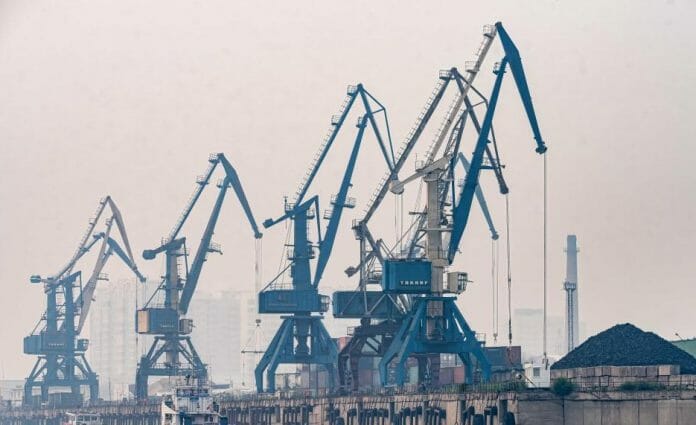China released its white paper on the Belt Road Initiative where it presents the achievements of the grand plan over the last 10 years, the State Council Information said it was to provide the international community with a better understanding of the benefits it had brought to the countries.
Since its launch in 2013, the Belt and Road Initiative has received both criticism and appreciation, while Asian countries like Malaysia, Vietnam, Thailand, and Africa see it as a progressive development, Sri Lanka has been one of the nations that remains a sore point for the Chinese government especially with the Western community labeling the BRI as having ulterior agenda.
According to the white paper, the ultimate goal of the BRI is to help build a global community with a shared future but China’s move in the South China Sea has ruffled feathers among the countries that share the coastline, like the Philippines and Vietnam.
The State recently published a map of the South China Sea region with its own depiction of ownership which irked ASEAN, the map appeared on Barbie the Movie which saw Vietnam banning the movie from playing in cinemas.
China said BRI had signed more than 200 cooperation agreements with more than 150 countries and 30 international organisations across five continents. Infrastructure connectivity — construction of six economic corridors: the China-Pakistan Economic Corridor, the New Eurasian Land Bridge Economic Corridor, the China-Indochina Peninsula Economic Corridor, the China-Mongolia-Russia Economic Corridor, the China-Central Asia-West Asia Economic Corridor, and the Bangladesh-China-India-Myanmar Economic Corridor. In Africa, railways such as the Mombasa-Nairobi Railway and the Addis Ababa-Djibouti Railway are now operational and have become important drivers of in-depth development in East Africa and across the entire continent.
On maritime connectivity — The Maritime Silk Road network has continued to expand. By the end of June 2023, it had reached 117 ports in 43 countries, and more than 300 well-known Chinese and international shipping companies, port enterprises, and think tanks, among other organizations, have joined the “Silk Road Maritime” association.
For Air connectivity — China has signed bilateral air transport agreements with 104 BRI partner countries and opened direct flight routes with 57 partner countries to facilitate cross-border transport.
International inter-modality transport — The China-Europe Railway Express now reaches more than 200 cities in 25 European countries. By the end of June 2023, the cumulative volume of the China-Europe Railway Express had exceeded 74,000 trips, transporting nearly 7 million twenty-foot equivalent units (TEUs) and over 50,000 types of goods in 53 categories, including automobiles, mechanical equipment and electronic products, with a total value of more than 300 billion U.S. dollars.
Trade and investment — From 2013 to 2022, the cumulative value of imports and exports between China and BRI partner countries was 19.1 trillion U.S. dollars, with an average annual growth rate of 6.4 percent. Cumulative two-way investment between China and partner countries came in at 380 billion U.S. dollars during the period, including some 240 billion U.S. dollars from China. By the end of August 2023, more than 80 countries and international organizations had subscribed to the Initiative on Promoting Unimpeded Trade Cooperation Along the Belt and Road, which was proposed by China. And China had signed 21 free trade agreements with 28 countries and regions.
Industrial cooperation — By the end of June 2023, China had signed agreements on industrial capacity cooperation with more than 40 countries. These countries have promoted cooperation on industrial capacity, expanded cooperation in traditional industries such as steel, non-ferrous metals, building materials, automobiles, engineering machinery, agriculture, and resources and energy, and explored cooperation in emerging industries such as the digital economy, new energy vehicles, 5G, and nuclear energy and technology.
Financial cooperation — By the end of June 2023, a total of 13 Chinese-funded banks had established 145 first-tier offices and branches in 50 BRI partner countries, some 17.7 million businesses in 131 partner countries had opened UnionPay banking services, and 74 partner countries had opened UnionPay mobile payment services. China has signed bilateral currency-swap agreements with 20 partner countries and established renminbi (RMB) clearing arrangements in 17 partner countries. China has funded the establishment of the Silk Road Fund (SRF) and opened the Asian Infrastructure Investment Bank (AIIB) with other participating countries. By the end of June 2023, the SRF had signed agreements on 75 projects with committed investment of about 22 billion U.S. dollars, there were 106 AIIB members, and the bank had approved 227 projects with a total investment of 43.6 billion U.S. dollars.
Culture and tourism cooperation — By the end of June 2023, China had signed cultural and tourism cooperation documents with 144 BRI partner countries.
Green development — China signed a memorandum of understanding with the United Nations Environment Programme on building a green Belt and Road for 2017-2022.
Scientific and technological innovation — By the end of June 2023, China had signed intergovernmental agreements on scientific and technological cooperation with more than 80 BRI partner countries.
The Digital Silk Road — By the end of 2022, China had signed MoUs on the construction of the Digital Silk Road with 17 countries, on e-commerce cooperation with 30 countries, and on closer digital economy investment cooperation with 18 countries and regions.
Poverty reduction — China has signed more than 100 agricultural and fishery cooperation documents with almost 90 BRI countries and international organizations.
Boosting employment — In the process of BRI cooperation, China said it has helped participating countries construct industrial parks and provided guidance for Chinese enterprises to create jobs for locals through high-level industrial cooperation. A McKinsey survey has revealed that Chinese firms in Africa recruit 89 percent of their employees locally, effectively contributing to local employment.
The World Bank has estimated that by 2030, BRI-related investment could lift 7.6 million people out of extreme poverty and 32 million out of moderate poverty.









